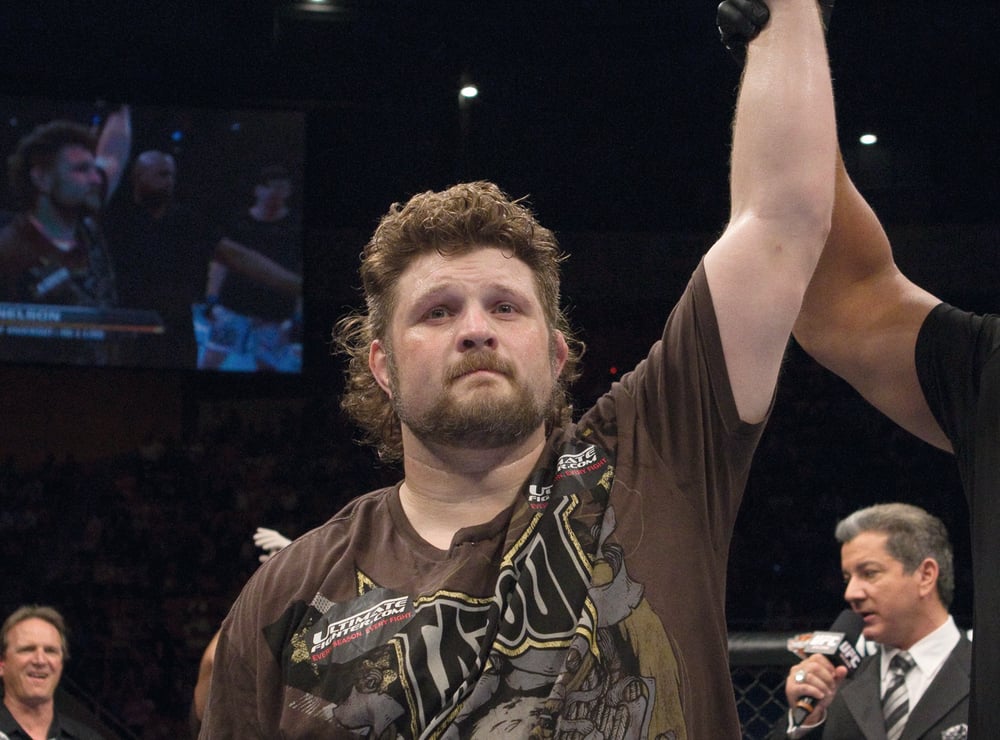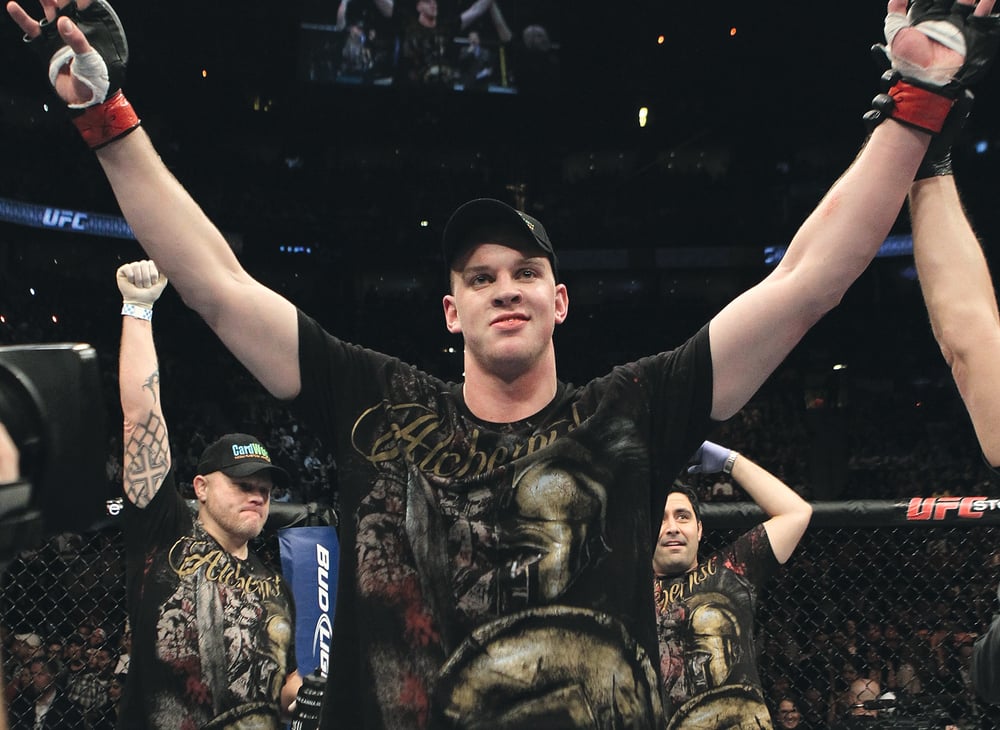
Issue 075
May 2011
FO’s experts and statisticians analyze three upcoming bouts
First, FO analyst Andrew Garvey takes a look at the state of play: what are the career implications for the combatants? Where are they coming from, and what will victory or defeat hold? Next, our technical editor Pete Irving breaks down the athletic considerations.
Jose Aldo vs Mark Hominick
UFC 129, April 30th, 2011, Toronto, Canada
20
Mark Hominick has only one knockout loss on his record. In his sixth fight eight years ago in February 2003, Hominick lost consciousness due to a slam. It was 20 months before José Aldo’s MMA debut
16
Combined, Aldo and Hominick are unbeaten in 16 fights. Aldo last lost in 2005 or 11 fights ago, while Hominick’s last ‘L’ was in 2008 or five fights ago
4
In his eight WEC bouts, Aldo has hit opponents with 263* solid strikes across 63 minutes of fighting. Averaging at a measly four hits per minute but scoring seven (T)KO finishes means Aldo must have dynamite in his limbs
35%
Aldo’s only loss came by submission to a rear naked choke. Of Hominick’s 20 wins, 35% have been tapouts, although he has attempted zero takedowns in his UFC/WEC career
78%
Aldo avoided 78% of strikes thrown at him in the WEC
THE BIGGER PICTURE
This is rarely a sport of fairytale endings. And Hominick (20-8) will enter his first UFC title fight with few expecting him to slay the fearsome featherweight champion Aldo, even with the backing of more than 50,000 Canadian fight fans in his home province of Ontario.
Riding a five-fight winning streak, the tidily effective kickboxer hasn’t lost since early 2008 when another featherweight title hopeful (at least until his disappointing showing in defeat at UFC 125) Josh Grispi caught him with a slick rear naked choke. Rebounding from that setback, ‘The Machine’ outclassed Savant Young at the first Affliction show and then signed with the WEC where he went 3-0 in 2010. Too good for Bryan Caraway and fellow Canadian Yves Jabouin, who Hominick bested in a fantastic scrap last June. He then beat the division’s wildest swinger Leonard Garcia with his far superior technique and accuracy. Moving to the UFC after the big merger, he earned a title shot with his clinical dismantling of former training partner George Roop in January. Hominick is guaranteed a thunderous ovation from the Rogers Centre mega-crowd but he’ll face a hostile, and potentially terrifying reception from the champion.
Without question one of the very best fighters in the sport, Aldo (18-1) will go into this fight the overwhelming favorite. However, he hasn’t fought since last September and was forced off the UFC 125 show with a compacted vertebrae that caused tingling in both arms. It’s an injury that may or may not end up hampering his seemingly inevitable path to legendary status. If Aldo’s fully healed there’s no reason why he shouldn’t be just as destructively brilliant as he was in the WEC cage. Only one fighter, Urijah Faber, has lasted the distance with Aldo since mid-2008. He may regret sticking it out, since the Brazilian so utterly dismantled him with leg kicks in one of the more lopsided high-level fights of recent memory. A superb grappler and excessively dangerous striker, Aldo has obliterated many other fighters, including Mike Brown and Manny Gamburyan. The only question mark is Aldo’s health, since any spinal injury can cause long-lasting problems. A fully healthy Aldo should, barring something shocking, make the first defense of his newly minted UFC featherweight title after successfully defending his WEC championship twice. Hominick is good, but Aldo is exceptional.
TECHNICAL BREAKDOWN
Hominick is an impressive striking package. He enforces a very close range, but carries his hands low around his chest, using tight head movement and parries rather than blocking punches. He deftly blocks kicks with two arms and replies promptly with neat hand combinations. Whilst he likes to dictate that tight space with his opponent, he’s always ready to hit the sprawl, quickly squaring up his stance and blocking the shoulders with both palms to prevent attempts to clinch or shoot.
A kickboxer of course, Hominick stays springy and light on his toes, hitting for speed over power, and preferring punches over kicks, knees and elbows. Aldo’s game owes more to traditional Muay Thai than western kickboxing, with a very complete repertoire of knees, kicks and elbows, combined with more flat-footed, less bouncy footwork. Where Hominick's punches are crisp, straight and well chosen, Aldo wails in barrages of hooks, looking to overwhelm his opponent.
Although Hominick has racked up his fair share of (T)KOs, nine of his 20 wins being stoppages from strikes, he’s not the heaviest of hitters. Accuracy and attrition are the hallmarks of the Canadian’s work, capable of keeping an intense pace over the course of the whole fight. Aldo is a brutal finisher with a keen killer instinct. All his work is delivered with bad intentions.
Hominick has respectable submission ability, but the Nova União fighter, Aldo, has to be considered the more dangerous ground fighter, with his masterful positional game and ultra-aggressive ground ‘n’ pound attacks.

Frank Mir vs Roy Nelson
UFC 130, May 28th 2011, Las Vegas, USA
Breakdown by the Numbers
Frank Mir 14-5-0 vs. Roy Nelson 15-5-0
7th
On average, Frank Mir’s UFC fights last 4:29, win or lose. It’s the seventh shortest duration of all UFC fighters
52
Against Junior Dos Santos, Roy Nelson suffered 52 power punches to the head yet remained standing through three rounds
3
While both are respected for their grappling abilities, Mir holds three more subs in MMA. Neither man has ever submitted in the ring
11
Of the 11 takedowns Nelson has attempted in the UFC, he has only completed one (11%)

THE BIGGER PICTURE
Aside from the constant verbal aggravation that makes him such a polarizing figure, two-time UFC heavyweight champion Frank Mir’s (14-5) main selling point has always been his ability on the mat. Here he’s in the unusual position of facing someone who once beat him under grappling rules. ‘Big Country’ Nelson (15-5), the first IFL heavyweight champion and The Ultimate Fighter 10 winner beat Mir at the 2003 Grappler’s Quest. Now, Mir will look for revenge inside the Octagon as two more fringe contenders jostle for the dubious honour of facing the likes of Cain Velasquez, Junior Dos Santos or Brock Lesnar for UFC gold.
Returning from injury, a decision loss to a composed, in-control Dos Santos and some messy contractual issues, Nelson will be looking for another quick, decisive win like the ones he earned over Brendan Schaub and Stefan Struve in 2009/10. In what could loosely be described as a fight, Mir and Mirko ‘Cro Cop’ trudged sluggishly about the Octagon like tired, disinterested sparring partners in the dullest UFC main event in a long time last September. Prior to that Mir was smashed to bits by Shane Carwin and badly needs a win to stay relevant as a title contender. That won’t be easy though, as Nelson, despite his well-fed trucker appearance is a very talented fighter.
TECHNICAL BREAKDOWN
Nelson hangs his left arm horizontally in front of him, guard low, with the rear hand cocked back, ready to let go his thundering, clubbing right, which is never quite a straight, and never quite a hook; more an overhand variation all of his own. ‘Big Country’ flicks out jabs from the elbow or offers up an arm-punch left hook with his ineffectual left hand, which essentially serves only to set up the right. Once he chases his opponents to ground, it’s again his right hand that does the lion’s share of the work.
With his huge belly to contend with, Nelson has no kicking or kneeing ability to speak of, preferring simply to box. Whatever the technical shortcomings of Nelson’s boxing, he cannot be faulted for power, boasting eight (T)KO’s on his 20-fight professional resume. The huge belly that inhibits his movement whilst standing serves to limit the movement of his opponents in the clinch and on the mat, as he sags them down with his outside trips and permits no space to escape his pin as his mass sprawls over them.
Mir has always had superb jiu-jitsu for a heavyweight with a vast repertoire of submissions at his disposal, and an ability to work from any position. The one-dimensional Nelson only plays well from top, and hasn’t submitted anyone since moving to higher-level competition in 2006. Mir has made great strides in his stand-up, bringing a far broader vocabulary of strikes than Nelson.

Stefan Struve vs Travis Browne
UFC 130, May 28th 2011, Las Vegas, USA
Breakdown by the Numbers
Stefan Struve 21-4-0 vs. Travis Browne 10-0-1
3
Stefan ‘Skyscraper’ Struve will have a three-inch reach advantage on Travis Browne.
3
Three is also their total heavyweight titles. Struve was Cage Gladiators champ while Browne had Gladiator Challenge and Victory Fighting belts
7
Struve’s long limbs have helped him secure seven triangle wins, and the move accounts for exactly half of his 14 tapouts
34%
In his two UFC fights, Browne has hit his target only 34% of the time when throwing strikes. Stefan Struve has a 52%? success rate
90%
90% of Travis Browne’s wins are via stoppage

THE BIGGER PICTURE
The tallest, and one of the youngest fighters under UFC contract, 6’11”, 22-year-old Dutchman Struve (21-4) is also one of the most exciting heavyweights in the sport. He’s talented, experienced with years left to mature, and his fights are always compelling. He’s gone 5-2 in the Octagon, starting disastrously with a 54-second loss to Junior Dos Santos. Gifted on the mat, and a dangerous striker with exceptional height and reach, Struve has a habit of getting himself in trouble early, then mounting a comeback, most notably in his UFC 117 knockout of Christian Morecraft.
Another massive specimen at 6’7” and some 250 pounds, undefeated (10-0-1) Browne is an explosive puncher, boasting five stoppage wins inside a minute. However, he has a lot to prove after his UFC 120 draw with Cheick Kongo. Expected to be an exciting stand-up war, the fight was an absolute stinker and if not for Kongo being docked a point for continually clutching Browne's shorts, Travis might have his first mark in the loss column.
Struve is the more skilled fighter. The young Dutchman has shown his vulnerability plenty of times before. However, Struve could well be a legitimate title contender one day while Browne – so far at least – is a big, hard-hitting dude with some gloves on. The Dutchman should be able to survive the early onslaught and take him out in the second or third round.
TECHNICAL BREAKDOWN
Struve often neglects to exploit his enormous reach advantage, preferring to come forward and engage with short punches or Thai-style clinch-and-knee tactics. Like all tall fighters who fight with a high elevation, Struve struggles to defend his hips, a problem compounded by his come-forward habits.
Struve compensates with a well-versed repertoire of typical “tall man’s” closed-guard attacks – slapping on the triangle with his long legs or reaching over for the guillotine with his lanky arms. Fourteen of his 21 victories have been via submission, each one by a variety of choke.
The four-inch shorter, heavily muscled knockout artist Browne boasts only one submission victory in his relatively limited 10 fight pro career, having dusted the majority of his opponents off in round one by KO or TKO, Browne is short on actual ring time. Struve too, in spite of having 25 fights in high-profile events around the world, has ended the majority in the first round, only once venturing into the third.










